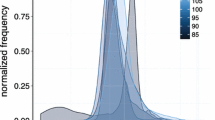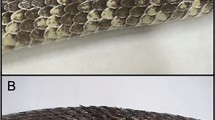Abstract
The use of bio-logging devices is important for describing behaviour, energy expenditure and activity budgets of cryptic marine organisms. In stingrays, the physical deployment of bio-logging devices is challenging due to their lack of raised structures or hard tissue for attachment. Previous studies have used a range of attachment techniques on various locations, including the pectoral musculature of the discs, spiracular cartilage or tail musculature. For devices such as accelerometers that capture precise animal movement, appropriate attachment and retention are important for collecting data that are representative of animal movement. Here, we detail a novel attachment method for bio-logging devices on stingrays using triaxial accelerometers that were attached through the musculature at the base of the tail of ten wild southern stingrays (Hypanus americanus). Data returned upon recapture suggest that stingrays exhibited active and non-active states and had the highest activity levels (vector sum acceleration) during the night with no apparent tide-associated activity patterns. Tag retention was 100% for all recaptured individuals (n = 8), with deployments lasting from 13 to 212 days. Wounds associated with the tagging process were completely healed for individuals that were recaptured after tag removal (n = 3). High rates of tag retention, usability and ecological significance of retrieved data, and complete healing following tag removal suggest that the methods described herein should be considered when attaching small bio-logging devices to large demersal rays for short- (weeks)-to-medium-term (months) studies.





Similar content being viewed by others
References
Blaylock RA (1990) Effects of external biotelemetry transmitters on behaviour of the cownose ray Rhinoptera bonasus (Mitchill 1815). J Exp Mar Biol Ecol 141:213–220
Bone Q, Roberts BL (1969) The density of elasmobranchs. J Mar Biol Assoc UK 49:913–937. https://doi.org/10.1017/S0025315400038017
Brownscombe JW, Lennox RJ, Danylchuk AJ, Cooke SJ (2018) Estimating fish swimming metrics and metabolic rates with accelerometers: the influence of sampling frequency. J Fish Biol 93:207–214
Carvalho F, Oliveira P, Hazin F, Piercy A, Burgess G (2010) Population structure and habitat utilization of the southern stingray Dasyatis americana (Hildebrand and Schroeder, 1928) at the Atol das Rocas Biological Reserve, Brazil. Braz J Oceanogr 59:104–111
Collins AB, Heupel MR, Motta PJ (2007) Residence and movement patterns of cownose rays Rhinoptera bonasus within a south-west Florida estuary. J Fish Biol 71(4):1159–1178
Connell SD, Underwood AJ, Chapman MG (2000) Observations in ecology: you can’t make progress on processes without understanding the patterns. J Exp Mar Biol Ecol 250:97–115
Cooke SJ, Brownscombe JW, Raby GD, Broell F, Hinch SG, Clark TD, Semmens JM (2016) Remote bioenergetics measurements in wild fish: opportunities and challenges. Comp Biochem Physiol Part A Mol Integr Physiol 202:23–37
Corcoran MJ, Wetherbee BM, Shivji MS, Potenski MD, Chapman DD, Harvey GM (2013) Supplemental feeding for ecotourism reverses diel activity and alters movement patterns and spatial distribution of the Southern stingray, Dasyatis americana. PLoS One. https://doi.org/10.1371/journal.pone.0059235
Di Santo V, Kenaley CP, Lauder GV (2017) High postural costs and anaerobic metabolism during swimming support the hypothesis of a U-shaped metabolism—speed curve in fishes. Proc Natl Acad Sci 114:13048–13053. https://doi.org/10.1073/pnas.1715141114
Fossette S, Katija K, Goldbogen JA, Bograd S, Patry W, Howard MJ, Knowles T, Haddock SHD, Bedell L, Hazen EL et al (2016) How to tag a jellyfish? A methodological review and guidelines to successful jellyfish tagging. J Plankton Res 00:1–17
Gilliam D, Sullivan KM (1993) Diet and feeding-habits of the southern stingray Dasyatis-americana in the central Bahamas. Bull Mar Sci 52:1007–1013
Gleiss AC, Dale JJ, Holland KN, Wilson RP (2010) Accelerating estimates of activity-specific metabolic rates in fishes: testing the applicability of acceleration data-loggers. J Exp Mar Biol Ecol 385:85–91
Halsey LG, Shepard ELC, Wilson RP (2011) Assessing the development and application of the accelerometry technique for estimating energy expenditure. Comp Biochem Physiol A Mol Integr Physiol 158:305–314
Hunter E, Buckley AA, Stewart C, Metcalfe JD (2005) Migratory behaviour of the thornback ray, Raja clavata, in the southern North Sea. J Mar Biol Assoc UK 85:1095–1105
Jorgensen SJ, Gleiss AC, Kanive PE, Chapple TK, Anderson SD, Ezcurra JM, Brandt WT, Block BA (2015) In the belly of the beast: resolving stomach tag data to link temperature, acceleration and feeding in white sharks (Carchardodon carcharis). Anim Biotelem. https://doi.org/10.1186/s40317-015-0071-6
Le Port A, Sippel T, Montgomery JC (2008) Observations of mesoscale movements in the short-tailed stingray, Dasyatis brevicaudata from New Zealand using a novel PSAT tag attachment method. J Exp Mar Biol Ecol 359:110–117. https://doi.org/10.1016/j.jembe.2008.02.024
Lewison RL, Crowder LB, Read AJ, Freeman SA (2004) Understanding impacts of fisheries bycatch on marine megafauna. Trends Ecol Evol 19:598–604. https://doi.org/10.1016/j.tree.2004.09.004
Lowe CG, Bray RN (2006) Fish movement and activity patterns. In: Allen LG, Horn MH, Pondella DJ (eds) The ecology of California marine fishes. University of California Press, Berkeley
Lowe CG, Goldman KJ (2001) Thermal and bioenergetics of elasmobranchs: bridging the gap. Environ Biol Fishes 60:251–266
McEachran JD, Aschliman N (2004) Phylogeny of batoidea. In: Carrier JC, Musick JA, Heithaus MR (eds) Biology of sharks and their relatives. CRC Marine Biology Series, Boca Raton
McEachran JD, Fechhelm JD (1998) Fishes of the Gulf of Mexico: myxinformes to gasterosteiformes, vol 1. University of Texas Press, Austin
O’Shea O, Ward CRE, Brooks EJ (2017) Range extension in Styracura (= Himantura) schmardae (Caribbean Whiptail Stingray) from the Bahamas. Caribb Nat 38:8
O’Toole AC, Murchie KJ, Pullen C, Hanson KC, Suski CD, Danylchuk AJ, Cooke SJ (2011) Locomotory activity and depth distribution of adult great barracuda (Sphyraena barracuda) in Bahamian coastal habitats determined using acceleration and pressure biotelemetry transmitters. Mar Freshw Res 61(12):1446–1456. https://doi.org/10.1071/MF10046
O’Shea O (2012) The ecology and biology of stingays (Dasyatidae) at Ningaloo Reef, Western Australia. Dissertation, Murdoch University
Otaki T, Hamana M, Tanoe H, Miyazaki N, Shibuno T, Komatsu T (2015) Three-dimensional mapping of red stingray (Dasyatis akajei) movement with reference to bottom topography. Ocean Sci J 50:327–334
Payne NL, Gillanders BM, Seymour RS, Webber DM, Snelling EP, Semmens JM (2010) Accelerometry estimates field metabolic rate in giant Australian cuttlefish Sepia apama during breeding. J Anim Ecol 80(2):422–430. https://doi.org/10.1111/j.1365-2656.2010.01758.x
Payne NL, Taylor MD, Watanabe YY, Semmens JM (2014) From physiology to physics: are we recognizing the flexibility of biologging tools? J Exp Biol 217:317–322. https://doi.org/10.1242/jeb.093922
Pinheiro J, Bates D, DebRoy S, Sarkar D, R Core Team (2018) _nlme: linear and nonlinear mixed effects models. R package version 3.1-137. https://CRAN.R-project.org/package=nlme. Accessed 6 Mar 2019
R Core Team (2018) R: a language and environment for statistical computing. R Foundation for Statistical Computing, Vienna, Austria. https://www.R-project.org/. Accessed 6 Mar 2019
Rollin BE, Kessel ML (1998) Guidelines for the treatment of animals in behavioural research and teaching. Anim Behav 55:251–257
Rosenblum HG, Long JH, Porter ME (2011) Sink and swim: kinematic evidence for lifting-body mechanisms in negatively buoyant electric rays Narcine brasiliensis. J Exp Biol 214:2935–2948. https://doi.org/10.1242/jeb.053108
Schindler DE, Essington TE, Kitchell JF, Boggs CH, Hilborn R (2002) Sharks and tunas: fisheries impacts on predators with contrasting life histories. Ecol Appl 12:735–748
Shepard ELC, Wilson RP, Quintana F, Gómez Laich A, Liebsch N, Albareda DA, Halsey LG, Gleiss A, Morgan DT, Myers AE et al (2008) Identification of animal movement patterns using tri-axial accelerometry. Endanger Species Res 10:47–60
Sherman RL, Gilliam DS (1996) Hepato-somatic indices and lifestyles in some batoid elasmobranchs. Fla Sci 59:275–278
Speed CW, O’Shea OR, Meekan MG (2013) Transmitter attachment and release methods for short-term shark and stingray tracking on coral reefs. Mar Biol 160:1041–1050
Stehfest KM, Lyle JM, Semmens JM (2015) The use of acoustic accelerometer tags to determine seasonal changes in activity and catchability of a recreationally caught marine teleost. ICES J Mar Sci J du Cons 72:2512–2520. https://doi.org/10.1093/icesjms/fsv115
Thiem JD, Dawson JW, Gleiss AC, Martins EG, Haro A, Castro-Santos T, Danylchuk AJ, Wilson RP, Cooke SJ (2015) Accelerometer-derived activity correlates with volitional swimming speed in lake sturgeon. Can J Zool 93(8):645–654
Tilley A (2011) Functional ecology of the southern stingray, Dasyatis americana. Bangor University, Bangor
Whitney NM, Papastamatiou YP, Holland KN, Lowe CG (2007) Use of an acceleration data logger to measure diel activity patterns in captive whitetip reef sharks, Triaenodon obesus. Aquat Living Resour 20(4):299–305. https://doi.org/10.1051/alr:2008006
Whitney NM, Pratt HL, Pratt TC, Carrier JC (2010) Identifying shark mating behaviour using three-dimensional acceleration loggers. Endanger Species Res 10:71–82. https://doi.org/10.3354/esr00247
Whitney NM, Papastamatiou YP, Gleiss AC (2012) Integrative multisensor tagging: emerging techniques to link elasmobranch behaviour, physiology, and ecology. In: Carrier JC, Musick JA, Heithaus MR (eds) Biology of sharks and their relatives, 2nd edn. CRC Press, Boca Raton, pp 265–290
Whitney NM, White CF, Gleiss AC, Schwieterman GD, Anderson P, Hueter RE, Skomal GB (2016) A novel method for determining post-release mortality, behaviour, and recovery period using acceleration data loggers. Fish Res 183:210–221. https://doi.org/10.1016/j.fishres.2016.06.003
Wilson RP, White CR, Quintana F, Halsey LG, Liebsch N, Martin GR, Butler PJ (2006) Moving towards acceleration for estimates of activity-specific metabolic rate in free-living animals: the case of the cormorant. J Anim Ecol 75:1081–1090. https://doi.org/10.1111/j.1365-2656.2006.01127.x
Wilson SM, Hinch SG, Eliason EJ, Farrell AP, Cooke SJ (2013) Calibrating acoustic acceleration transmitters for estimating energy use by wild adult Pacific salmon. Comp Biochem and Phys Part A 164:491–4980
Wright S, Metcalfe J, Hetherington S, Wilson R (2014) Estimating activity-specific energy expenditure in a teleost fish, using accelerometer loggers. Mar Ecol Prog Ser 496:19–32
Yoda K, Naito Y, Sato K, Takahashi A, Nishikawa J, Ropert-Coudert Y, Kurita M, Le Maho Y (2001) A new technique for monitoring the behaviour of free-ranging Adélie penguins. J Exp Biol 204:685–690
Acknowledgements
The authors would like to thank N. Firing, C. Grossi, R. Hallinan, K. Luniewicz, M. Marsh, the Island School Stingray Class of fall 2015, and countless volunteers and students who helped locate and catch stingrays. The authors would also like to thank two anonymous reviewers for many insightful comments and suggestions on earlier drafts of this manuscript. Jake Brownscombe provided invaluable guidance in the initial phases of this project. Funding for this project was provided by the Cape Eleuthera Foundation. Ian Bouyoucos is supported by an Australian Government Research Training Program Scholarship.
Author information
Authors and Affiliations
Corresponding author
Ethics declarations
Data availability statement
The datasets during and/or analysed during the current study are available from the corresponding author on reasonable request.
Conflict of interest
All authors declare they have no conflict of interest.
Ethics statement
Research was conducted under permits MAF/FIS/17 and MAF/FIS/13, issued by the Bahamian Department of Marine Resources. Animal care protocols were based on guidelines from the Association for the Study of Animal Behaviour and the Animal Behaviour Society (Rollin and Kessel 1998).
Additional information
Responsible Editor: J. K. Carlson.
Publisher's Note
Springer Nature remains neutral with regard to jurisdictional claims in published maps and institutional affiliations.
Reviewed by Undisclosed experts.
Rights and permissions
About this article
Cite this article
Ward, C.R.E., Bouyoucos, I.A., Brooks, E.J. et al. Novel attachment methods for assessing activity patterns using triaxial accelerometers on stingrays in the Bahamas. Mar Biol 166, 53 (2019). https://doi.org/10.1007/s00227-019-3499-z
Received:
Accepted:
Published:
DOI: https://doi.org/10.1007/s00227-019-3499-z




